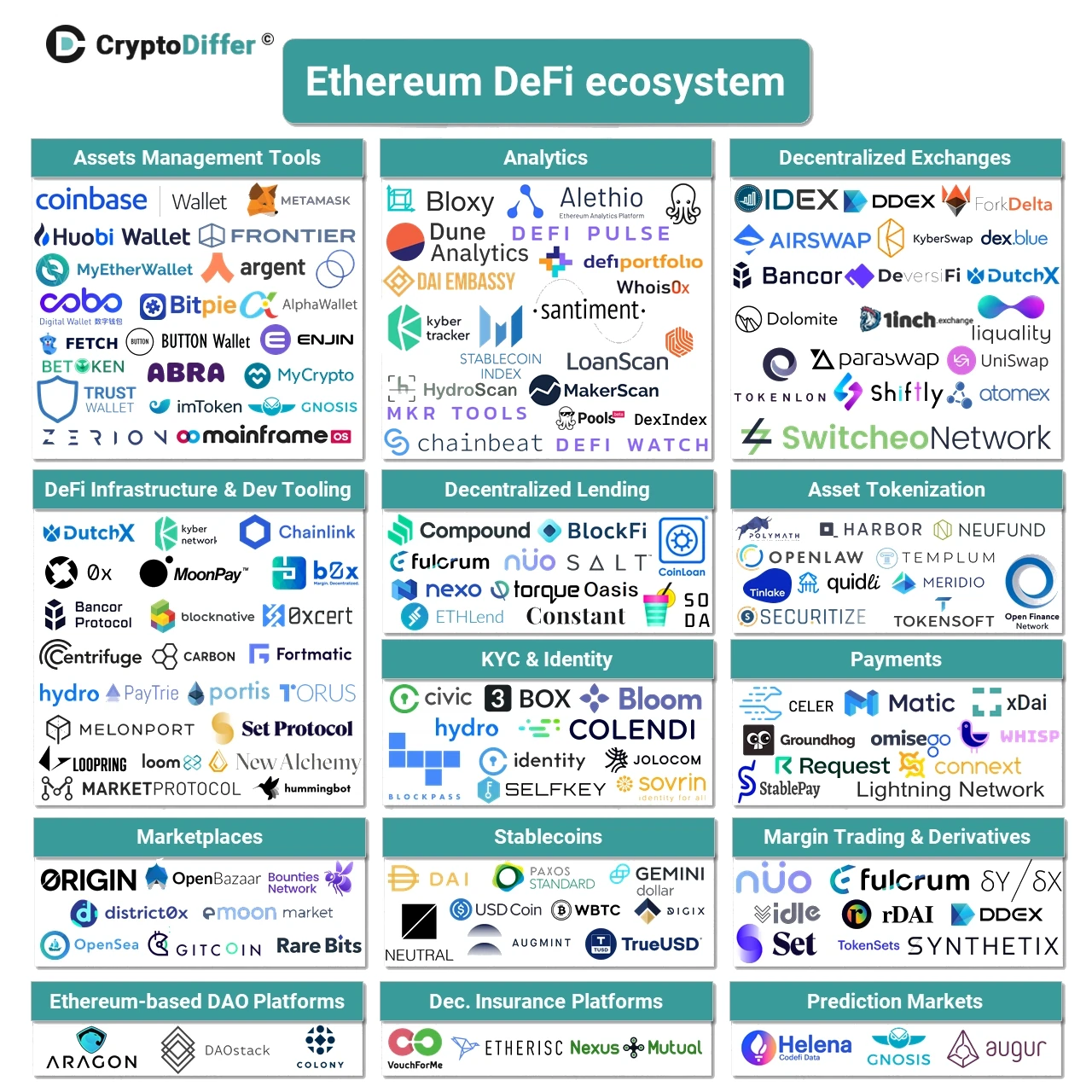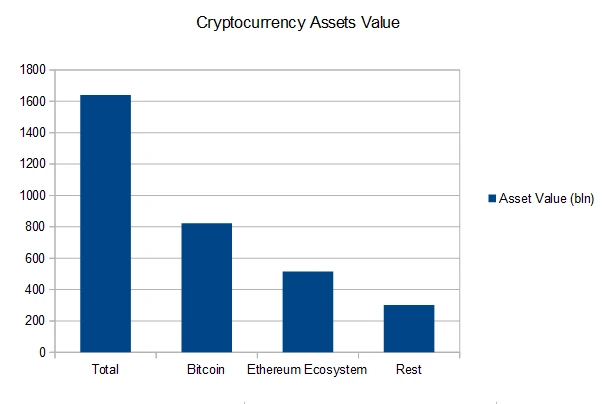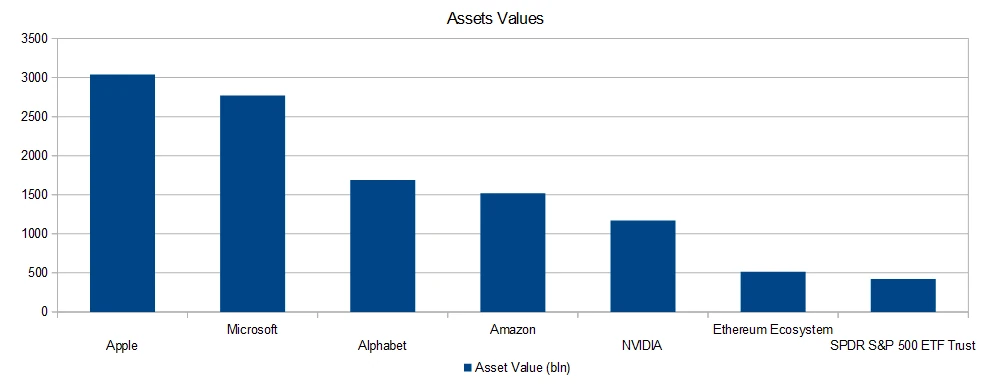Introduction to Ethereum

Ethereum is one of the cryptocurrencies that places great emphasis on their practical use, indeed. Surely, along with the practicality of use, a large number of applications have appeared. In this case, the Ethereum ecosystem almost crushed the competition.
Of course, this article is about the Ethereum ecosystem.
I will take you, the reader, to the digital world of the second most important cryptocurrency on the cryptocurrency market.
I will also tell you a little about Ethereum’s history, advantages and challenges. Then I will talk about the future of the ecosystem and Etherum itself.
I will end all this with numbers confirming my theses, indeed. So, I invite you to read!
Understanding the Ethereum Ecosystem
Firstly, to fully understand the power of Ethereum, you must first familiarize yourself with the ecosystem.
At its core, it is a decentralized platform of Smart Contracts and also Decentralized Applications.
Clearly, the entire ecosystem is built on blockchain technology. If you are a blog reader, then you should already know quite a lot about it. Unlike Bitcoin, Ethereum is not just a cryptocurrency, but primarily a platform.
So, what platform are we talking about?
I’m translating now. It is a platform for developers to build their own applications. Clever, isn’t it?
At this point, you shouldn’t be surprised by Ethereum’s capitalization (second after Bitcoin).
Further, I forgot to add that the application programs are written in the native programming language, Solidity.
Well, surely it’s time to write a little about the genesis and development of the Ethereum project.
The History and Growth of Ethereum
As I promised, a little about the history of the project, indeed.
It seems reasonable to say that the history of cryptocurrencies began on October 31, 2008, surely it is.
From a document describing the Bitcoin project.
The implementation of the Bitcoin project started at the beginning of 2009 and then …
What does this actually have to do so with the Ethereum project?
Well, Vitalik Buterin first wrote texts for Bitcoin Magazine, and then. Exactly.
It was undoubtedly thanks to this magazine that his idea for the Ethereum project was born.
All this took place in 2013.
Firstly, the project itself has been officially developed since 2015. Since then, Ethereum has experienced tremendous growth.
Almost to the moon! In fact, there are many investors and programmers around the project.
Why not take advantage of the benefits the project offers? Oh, that’s foolish.
Secondly, the native cryptocurrency, Ether (ETH) is one of the most valuable digital assets on the market.
Thirdly, society is constantly growing. Lots of new projects are being created by developing the Ethereum ecosystem, surely to say.
Many existing projects are being further dynamically developed.
Finally, the Ethereum ecosystem already has several years of history, and one of the significant moments in the history of the cryptocurrency was the fork of the original Ethereum blockchain.
Today called Ethereum Classic.
The Benefits of Using Ethereum
First of all, one of the greatest advantages are Smart Contracts, indeed.
Particularly, it was in Ethereum that this function was first used. What are Smart Contracts, then?
Yeah, it’s worth stopping here for a moment to at least outline their meaning.
Well, Smart Contracts are self-executing contracts based on the conditions written in the contract, so…
Thus, the contract will be fulfilled when the conditions are met. All this eliminates the need for intermediary between the transaction and efficiency, of course.
However, you probably already know this. This one feature opened up the pool of possibilities.
Start from decentralized applications (DeFi) to supply chain management and so on.
Another advantage of using Ethereum is global availability.
Basically, anyone who has access to the Internet can take advantage of the benefits of Ethereum.
All this further promotes the adoption of cryptocurrencies around the world.
Without a doubt, these are not all of the mentioned advantages of Ethereum and its ecosystem. I will leave you, the reader, with only these two advantages, and the rest of the article should convince you to choose Ethereum.
As for the rest, you’ll see what I mean.
Applications in Ethereum Ecosystem
The Ethereum ecosystem is a habitat for a variety of applications, surely. Each application serves a specific purpose.
One of the most famous applications is decentralized finance (DeFi).
DeFi protocols enable users to access financial services, in reality. All this without the need to use intermediaries such as banks.
These apps offer features such as lending, borrowing and trading. Everything is based on smart contracts. Without a doubt, DeFi has gained popularity in recent years and has the potential to disrupt traditional financial systems.
Beyond DeFi, Ethereum is also underpinning the surge in non-fungible tokens (NFTs). NFTs are unique digital assets that can represent ownership of art, music, collectibles and so much more.
The Ethereum blockchain provides the infrastructure for the creation, trading and also ownership of these one-of-a-kind digital assets. NFTs have gained mainstream attention, indeed.
So artists, musicians and celebrities have embraced this new form of digital ownership and expression.

Significant Projects in Ethereum Ecosystem
Wow. It was while writing this subsection that I realized what.
Let me share this with you. You’ll probably be as shocked as I was. Of the first twenty projects with the largest market capitalizations, eleven of them belong to the Ethereum ecosystem.
Do you now see how important Ethereum is as a cryptocurrency?
However, I will go a little further and mention a few of them.
Do you know stablecoins?
Tether, USD Coin and DAI are projects of the Ethereum ecosystem.
What about Binance Coin, Polygon or Chainlink?
Well, I guess you already know what I want to write.
The Ethereum ecosystem is powerful.
The strength and number of projects emerging in this ecosystem is enormous.
Once again wow. It was only while writing this article that I realized this.
Why Ethereum Ecosystem?
The Ethereum ecosystem consists of a multitude of applications of all kinds.
Basically, other altcoins try to copy and modify the solutions used in this ecosystem. Either way, it is the innovation of smart contracts that has given it a huge competitive advantage.
Other ecosystems related to Solana, BNB, Arbitrum, Polygon or Solana are emerging, but…
They are light years behind the Ethereum ecosystem.
You could say that this ecosystem is the size of all ecosystems combined.
This statement seems exaggerated, but is it really?
Smart Contracts on Ethereum
Smart contracts are the backbone of the decentralized finance revolution.
They eliminate the need for intermediation in the transaction. While maintaining automation and trust. DeFi applications take full advantage of the power of Smart Contracts.
As a result, services related to lending, borrowing, trading and yield farming were created.
Thanks to DeFi, individuals can take responsibility for their own assets. Isn’t your job useful and cool?
DeFi is booming, but there is still a long way to go to achieve full success.
The problems of both cryptocurrencies and DeFi applications are scalability and security.
If you read this blog regularly, you probably already know this. And very well!
NFTs on the Ethereum Ecosystem
The rise of non-fungible tokens (NFTs) has taken the crypto world by storm, and Ethereum has played a significant role in this phenomenon.
NFTs are unique digital assets that can represent ownership of various digital and physical items.
Artists, musicians, and creators have embraced NFTs as a new way to monetize their work and engage with their fans.
The Ethereum blockchain provides the infrastructure for the creation, trading, and ownership of NFTs, making it the go-to platform for this booming market.
The impact of NFTs goes beyond art and collectibles. They have the potential to revolutionize industries such as gaming, real estate, and even identity verification.
With the ability to prove ownership and authenticity in a decentralized manner, NFTs pave the way for new business models and creative possibilities.
Ethereum Consensus Mechanism
Historically, Ethereum has been supported by the Proof-of-Work consensus mechanism.
In this consensus, miners validate transactions and secure the network.
Currently, the Ethereum network and naturally its ecosystem supports the Proof-of-Stake mechanism.
Well, let’s talk about it briefly.
More About Staking
A few words about Ethereum staking, because this is not what this article is about.
Ethereum staking allows you to use cryptocurrency in exchange for helping secure the Ethereum blockchain network.
Before the network modernization, Ethereum used a Proof-of-Work consensus mechanism.
Similar to other blockchain network such as Bitcoin, Litecoin, and Monero.
After that Ethereum using a different and more efficient Proof-of-Stake (PoS) consensus mechanism.
Challenges and Limitations of Ethereum
Despite its success, Ethereum faces several challenges and limitations.
One of the main challenges is scalability.
As the number of users and applications on the network increases, the Ethereum blockchain has become congested, resulting in high fees and slower transaction times. Ethereum 2.0 aims to address this issue by introducing sharding and other scalability solutions.
Another limitation of Ethereum is its reliance on developers to write secure smart contracts.
Unlike traditional software, smart contracts are immutable once deployed, meaning that any bugs or vulnerabilities cannot be easily fixed.
This has led to incidents where smart contracts have been exploited, resulting in significant financial losses.
However, the Ethereum community is constantly working on improving the security and auditing processes to mitigate these risks.
The Future of Ethereum
The future of Ethereum looks promising.
In Ethereum upgrade, scalability and energy efficiency were significantly improved, opening the doors to even more applications and users.
Ethereum has positioned itself as the go-to platform for decentralized finance, and as DeFi continues to grow, Ethereum’s value and influence will only increase.
Furthermore, the integration of NFTs into mainstream industries has just scratched the surface, and Ethereum will play a crucial role in shaping this emerging market.
Ethereum Ecosystem Numbers
It’s time to talk about numbers. As you probably know, these say more than a thousand words.
It’s a phrase borrowed from an ad, but whatever. It fits here like a glove.
Let me start with the facts. The market capitalization of cryptocurrencies is $1.64 trillion.

Of which 31.4 percent is the Ethereum ecosystem. Little?
So let me add something else. Together with Bitcoin, the Ethereum ecosystem accounts for 81.4 percent.
So what do you say now?
Oooo, I forgot to add that I limited myself only to projects whose market capitalization exceeded one billion dollars.
I only made calculations for these projects. And at the time of writing the article, there were 65 such projects.
Guess what else I want to add? In fact, these 65 projects represent 92 percent of the market capitalization of the entire cryptocurrency market. Do you understand what I’m trying to tell you now? If so, that’s fine.
It means you are the right person reading this blog. If you don’t get it, it means that you are familiar with logical thinking problems. I don’t want to offend, but the obvious should not be explained.
However, I went a bit further and decided to compare the Ethereum ecosystem not only with assets on the cryptocurrency market, but also with share prices and the largest ETF, S&P 500.
Ethereum Ecosystem Vs Big Tech Stocks

It’s time to explain what we see on the chart.
It is very clear that the market capitalization of the Ethereum ecosystem is smaller than the top 5 market capitalizations of tech giants.
And in the case of the largest ETF, the S&P 500, it is clear that the ecosystem is already larger.
NVIDIA has the smallest market capitalization of the 5 tech giants. The company’s shares have gained strongly due to technological advances in artificial intelligence.
Wait a minute.
I was actually going to write that the Ethereum ecosystem accounts for 44 percent of NVIDIA’s market cap.
In the case of Apple, it is 17 percent.
Say what you want, but comparing the tech giant and having 17 of its market capitalization in just 10 years is still a lot!
I wanted to finish by writing about the most popular projects in the ecosystem, but I’ll skip it. The most popular project in the media is Ethereum itself and that should be enough for you!
Resources and Tools
If you’re interested in exploring Ethereum and its ecosystem, there are several resources and tools available to help you get started.
The official Ethereum website provides comprehensive documentation, tutorials, and developer resources for those looking to dive into the technical aspects of Ethereum.
Additionally, there are various online communities, forums, and social media groups where you can connect with like-minded individuals and learn from their experiences.
Conclusion
Ethereum has cemented its position as the leading cryptocurrency and continues to shape the future of decentralized applications and digital transactions, surely.
Without a doubt, its thriving ecosystem, powered by smart contracts and decentralized finance, has revolutionized the way we think about finance and ownership. With the rise of NFTs and the Ethereum upgrade, the potential of Ethereum is only just beginning to be realized, so don’t miss it.
Then, whether you’re an investor, developer, or simply curious about the world of cryptocurrencies, Ethereum is a force to be reckoned with.
Embrace the power of Ethereum and then join the revolution today.

Leave a Reply
You must be logged in to post a comment.